Montana Seeks to Loosen Food and Agricultural Regulations
Montana is looking to loosen some food regulations in the state. That's good, because there's room for improvement.


Montana is looking to loosen some food regulations in the state.
By passing a 2013 law, HB 630, Montana legislators required regulators there to find ways to streamline and loosen the state's tangled web of food regulations. The law sought new ideas for fixing the "complex food code with jurisdiction spread between multiple departments and levels of government" and addressing the "growing movement to support locally sourced and community-based food production[.]"
The law mandated a trio of listening sessions—which recently wrapped up—and opened up the process to public comments, which are expected to help the legislature's Economic Affairs Interim Committee draft a series of new reform bills next year.
HB 630 provides a welcome opportunity for Montanans—and those in other states—to consider the ways that regulations can impede agricultural and food entrepreneurship. That problem is national in scope.
Many Montanans appear pleased that the state may release its grip on their purses and plates.
"If there was some kind of streamlining of regulations, that would have a real value in our business," said Eric Bergman, an organic vegetable, pork, and poultry farmer, in a recent Great Falls Tribune piece on the legislation.
But others have expressed reservations.
Matt Kelley, a Montana health department director, "expressed reservations about [an existing] law and any expansion that would add more products to the exemption," reports the Bozeman Daily Chronicle.
While at least some of the conversation appears to revolve around Cottage Foods, according to a comprehensive 2013 report by Harvard Law School's Food Law & Policy Clinic, Montana already has a Cottage Food law on the books.
The fifty-state report, Cottage Food Laws in the United States, notes that Montana permits Cottage Food operations; allows a "limited list" of approve foods; has no "registration, permit, or licensing requirements"; has no dollar limit on sales; and is one of only three states with no labeling requirements.
In short, the Harvard report indicates Montana's Cottage Food law is already a reasonably good one. In looking to tweak the law, I'd love to see Montana increase the number and type of foods covered under the law. I'd also like to see the state implement some minimum, basic labeling requirements—including requiring that the name and address of the producer and the list of all ingredients appear on any packaging. (And yes, note in that latter sentence that I'm suggesting adding a new food regulation.)
But beyond Cottage Foods, Montana has many areas where it can and should improve the regulatory climate in the state for agricultural and food entrepreneurs.
For example, Montana regulators have needlessly hindered poultry farmers in the state.
"Chicken farmers, in particular in this state, were hard pressed getting started because we kept getting resistance from several different regulatory agencies," said Montana farmer Mark Rehder, in a 2013 Chronicle report. "It makes it difficult for emerging farmers to get a foothold."
And when farmers have tried to take advantage of federal rules that permit small poultry farmers to process their own chickens, Rehder told the Chronicle, the Montana Department of Livestock has scoffed at the federal rule.
"The Department of Agriculture has told us to sue to get that recognized," Rehder said. "It's largely why there aren't any chicken farmers in the state."
In the same report, Montana rancher Jenny Sabo lamented that the Department of Livestock has actively opposed raw milk sales in the state.
And Nate Brown, an organic farmer and dairyman, told the Chronicle that thanks to a tangled web of Department of Livestock licenses and permits (and related fees). Brown estimates he holds up to 20 licenses from the Department of Livestock alone.
Moving from the farm to the marketplace, Montana's farmers market regulations appear to be more complex than is necessary. For example, while the state doesn't require a license for vendors who sell whole fruits, vegetables, or cheeses, any sliced produce or cheeses "must be approved through the county sanitarian and licensed by the state health department before being sold to the public." Montana also cracked down on the sale of local eggs at farmers markets last year.
How complex are some of the state's overlapping livestock, produce, and health regulations? At one of the listening sessions, Joel Clairmont, the deputy director of Montana's Department of Agriculture, explained how in one instance he and several existing businesses were forced by his fellow regulators to wait more than five years to cut through the red tape necessary to establish a dried beef business.
Reforming alcohol regulations should also make its way into the mix. A battle between Montana brewers and taverns escalated last year until it became national news. Instead of considering more stringent rules, the state should loosen restrictions on taverns and breweries alike.
There's no shortage of areas of food and agricultural regulation that Montana's legislators can't work to improve. Reaching out for public comment on these issues—the comment period ends on Feb. 17—is a great first step. After that, the legislature must act. The proof will be in the pudding*.
*According to Montana foodservice regulations, it appears many puddings may not be served at a temporary food service establishment in Montana.


Show Comments (65)